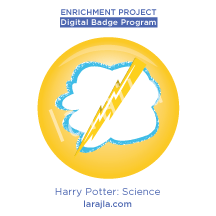These experiments are sorted into length of time to complete. If you’re doing a day camp, starting crystals on the first day will allow your kids to see a progression during a week. Shorter experiments can be used after starting a longer one or for shorter events.
You can use those given below or select your own experiments. Since most science experiments do things that appear “magical”, the number to choose from is great.
Steps
Longer experiments
1. Grow crystals.
Using either salt or sugar and water, grow crystals. Make sure you have some that you have grown for examples.
2. Seeds/beans growing.
Growing a seed in water allows your participants to see roots start to grow. Your container needs to be clear as well. This project may also be used for “Herbology.”
3. Terrarium.
Create a miniature world within a bottle or other clear container. This is another possibility for “Herbology.”
Shorter experiments
4. Sun prints.
Using construction paper, use the magic of the sun to make prints.
5. Disappearing / invisible ink.
Lemon juice, sweat, saliva or experiment with recipes to create disappearing ink. See the Enrichment Project supplement or find your own recipes for experimenting.
6. Slime.
Find your favorite recipe for slime. If you don’t have one, experiment with those you find on the Web until you get one you are happy with.
7. Carbon dioxide potion.
Combine water, baking soda and vinegar to make carbon dioxide bubbles. Place this in a beaker or cauldron. Determine the amount you need and adjust for your container.
8. Magical fire.
Varying chemicals can change the color of the flames. Find sources for these materials to color your night fire.
- Calcium — red flame
- Copper — green flame
- Sodium — orange flame
- Lithium — pink flame
- Lead — blue flame
- Potassium — purple flame
- Barium — light green flame
NOTE: Other materials can also make your fire magical such as granulated sugar will spark.
9. Paper chromatography.
Chromatography allows you to analyze complex mixtures by separating them.
You can make this a mystery where your participants have to match the ink on a note. Compare with sample pens you have to determine who wrote the note.
10. Levitating feather.
www.mrsruss.com/Science/potter2.htm
Try both the scientific and magical approaches to levitating a feather.
11. Reducio!
www.mrsruss.com/Science/reducio.htm
Reducio! Is a spell to reduce the size of an item. Do the experiment in the link to make an egg fit into a bottle.
12. Dry ice for all.
The smoking dry ice allows you to make fog or sinking bubbles. Search the Web and try a variety of dry ice experiments. Pick a few to share with your participants.
13. Magical balloon.
Use vinegar and baking soda in a soda bottle to blow up a balloon. Be able to explain what happens.
14. Dancing colors.
A few drops of food coloring placed into warm milk and dish soap in a bowl makes the coloring dance on the surface of the milk. Find more out about this experiment and try it yourself.
15. Lava lamp.
Make a lava lamp out of household materials. Be sure to provide any warnings necessary before building these.
16. Wizard goop.
Find a recipe and make silly putty for wizard goop.
17. More experiments.
Don’t stop now. Explore sites and books to find more experiments. Share those you find work well with other AEP members.
Supplements Available
Sites to Explore
- guidezone.e-guiding.com/bvfmagic.htm
- www.mrsruss.com/Science/disappea.htm
- www.dadcando.com
- www.campfiredude.com/campfire-magic.shtml
- www.make-stuff.com/formulas_&_remedies/home_&_hearth/flames.html
- scienceblogs.com/ethicsandscience/2007/07/27/fun-with-paper-chromatography
- www.mrsruss.com/Science/potter4.htm
- www.stevespanglerscience.com/experiment/awesome-dry-ice-experiments
- www.weirdsciencekids.com/dryice.html
- www.ehow.com/how_5668084_make-sun-prints-construction-paper.html
- www.wisegeek.com/how-do-i-make-a-sun-print.htm
- www.instructables.com/id/Science-Experiment-Inflate-a-Balloon-with-Vinegar
- www.funology.com
- hobbyscience.com/colorsdance.html
- www.wikihow.com/Make-a-Lava-Lamp-with-Household-Ingredients
- www.stevespanglerscience.com/experiment/00000035

Leave a Reply